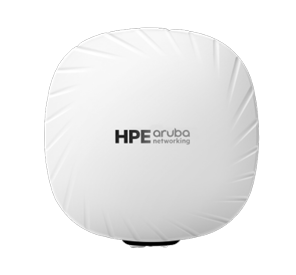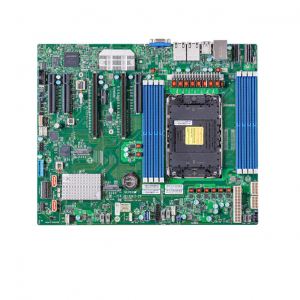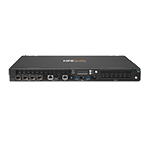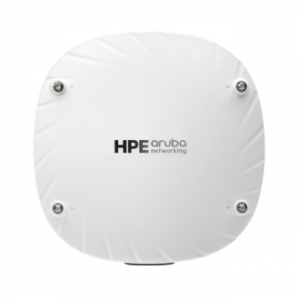ADDITIONAL WI-FI FEATURES
Each AP also includes the following standards-based
technologies:
• Transmit Beamforming: Increased signal reliability and
range
• Passpoint Wi-Fi (Release 2) (Hotspot 2.0): Seamless
cellular to Wi-Fi handover for guests
• Dynamic Frequency Selection (DFS): Optimized use of
available RF spectrum
• Maximum Rate Combining (MRC): Improved receiver
performance
• Cyclic Delay/Shift Diversity (CDD/CSD): Greater
downlink RF performance
• Space-Time Block Coding (STBC): Increased range and
improved reception
• Low-Density Parity Check (LDPC): High-efficiency error
correction for improved throughput
SPECIFICATIONS
Hardware variants
• AP-503: Campus AP platform, integrated antennas
Wi-Fi radio specifications
• AP type: Indoor, dual-radio, 2.4GHz and 5GHz (dual
concurrent) 802.11ax 2x2 MIMO
• 2.4GHz radio: Two spatial stream Single User (SU) MIMO
for up to 574Mbps wireless data rate with 2SS HE40
802.11ax client devices (287Mbps for HE20)
• 5GHz radio: Two spatial stream Single User (SU) MIMO for
up to 1.2Gbps wireless data rate with 2SS HE80 802.11ax
client devices
• Up to 256 associated client devices per radio, and up to
16 BSSIDs per radio
• Supported frequency bands (country-specific restrictions
apply):
- 2.400 to 2.4835GHz ISM
- 5.150 to 5.250GHz U-NII-1
- 5.250 to 5.350GHz U-NII-2A
- 5.470 to 5.725GHz U-NII-2C
- 5.725 to 5.850GHz U-NII-3/ISM
- 5.850 to 5.895GHz U-NII-4
• Available bands and channels: Dependent on configured
regulatory domain (country)
• Dynamic frequency selection (DFS) optimizes the use of
available RF spectrum in the 5GHz band
• Supported radio technologies:
- 802.11b: Direct-sequence spread-spectrum (DSSS)
- 802.11a/g/n/ac: Orthogonal frequency-division
multiplexing (OFDM)
- 802.11ax: Orthogonal frequency-division multiple access
(OFDMA) with up to 8 resource units
• Supported modulation types:
- 802.11b: BPSK, QPSK, CCK
- 802.11a/g/n: BPSK, QPSK, 16-QAM, 64-QAM and 256-
QAM (proprietary extension)
- 802.11ac: BPSK, QPSK, 16-QAM, 64-QAM, 256-QAM and
1024-QAM (proprietary extension)
- 802.11ax: BPSK, QPSK, 16-QAM, 64-QAM, 256-QAM and
1024-QAM
• 802.11n high-throughput (HT) support: HT20/40
• 802.11ac very high throughput (VHT) support:
VHT20/40/80
• 802.11ax high efficiency (HE) support: HE20/40/80
• Supported data rates (Mbps):
- 802.11b: 1, 2, 5.5, 11
- 802.11a/g: 6, 9, 12, 18, 24, 36, 48, 54
- 802.11n: 6.5 to 300 (MCS0 to MCS15, HT20 to HT40),
400 with 256-QAM (proprietary extension)
- 802.11ac: 6.5 to 867 (MCS0 to MCS9, NSS = 1 to 2,
VHT20 to VHT80); 1,083 with 1024-QAM (MCS10 and
MCS11, proprietary extension)
- 802.11ax (2.4GHz): 3.6 to 574 (MCS0 to MCS11, NSS = 1
to 2, HE20 to HE40)
- 802.11ax (5GHz): 3.6 to 1,201 (MCS0 to MCS11, NSS = 1
to 2, HE20 to HE80)
• 802.11n/ac packet aggregation: A-MPDU, A-MSDU
• Transmit power: Configurable in increments of 0.5 dBm
• Maximum (aggregate, conducted total) transmit power
(limited by local regulatory requirements):
- Per radio (2.4GHz / 5GHz): +21 dBm (18dBm per chain)
- Note: conducted transmit power levels exclude antenna
gain. For total (EIRP) transmit power, add antenna gain.
• Advanced Cellular Coexistence (ACC) minimizes the impact
of interference from cellular networks
• Maximum ratio combining (MRC) for improved receiver
performance
• Cyclic delay/shift diversity (CDD/CSD) for improved
downlink RF performance
• Space-time block coding (STBC) for increased range and
improved reception
• Low-density parity check (LDPC) for high-efficiency error
correction and increased throughput
• Transmit beam-forming (TxBF) for increased signal
reliability and range
• 802.11ax Target Wait Time (TWT) to support low-power
client devices
Wi-Fi antennas
• AP-503: Integrated downtilt omni-directional antennas
for 2x2 MIMO with peak antenna gain of 1.7dBi in 2.4GHz
and 4.8dBi in 5GHz. Built-in antennas are optimized for
horizontal ceiling mounted orientation of the AP. The
downtilt angle for maximum gain is roughly 30 degrees.
- Combining the patterns of each of the antennas of the
MIMO radios, the peak gain of the combined, average
pattern is 1.5dBi in 2.4GHz and 3.9dBi in 5GHz.
Other interfaces and features
• E0: Ethernet wired network port (RJ-45)
- Auto-sensing link speed (10/100/1000BASE-T) and MDI/
MDX
- POE-PD: 48Vdc (nominal) 802.3af POE (class 3 or higher)
- 802.3az Energy Efficient Ethernet (EEE)
• USB 2.0 host interface (Type A connector)
- Capable of sourcing up to 100mA / 500mW to an
attached device
• Built-in Trusted Platform Module (TPM) for enhanced
security and anti-counterfeiting
• Visual indicators (two multi-color LEDs): for System and
Radio status
• Reset button: factory reset, LED mode control (normal/off)
• Serial console interface (proprietary, micro-B USB physical
jack)
• Automatic thermal shutdown and recovery function
Power sources and power consumption
• The AP supports Power over Ethernet (POE) on port E0
• Power sources are sold separately; see the 503 Series
Ordering Guide for details
• Maximum (worst-case) power consumption: 10.9W
• Maximum (worst-case) power consumption in idle mode:
4.7W
• Both numbers assume no power is drawn from the USB
interface
- Drawing 0.5W from the USB interface increases max AP
power consumption by up to 0.7W
Mounting details
A generic mount bracket to attach the AP-503 to suspended
ceiling rails ships with the AP. Alternate or spare brackets can
be ordered separately; see the 503 Series Ordering Guide for
details.
Mechanical specifications
• Dimensions/weight (AP-503; unit with mount bracket):
- 145mm (W) x 145mm (D) x 51mm (H)
- 270g
• Dimensions/weight (AP-503; unit without mount bracket):
- 145mm (W) x 145mm (D) x 35mm (H)
- 255g
• Dimensions/weight (AP-503; shipping):
- 196mm (W) x 183mm (D) x 67mm (H)
- 515g
Environmental specifications
• Operating conditions
- Temperature: 0C to +40C / +32F to +104F
- Relative humidity: 5% to 95%
- ETS 300 019 class 3.2 environments
- AP is plenum rated for use in air-handling spaces
• Storage conditions
- Temperature: -25C to +55C / +13F to +131F
- Relative humidity: 10% to 100%
- ETS 300 019 class 1.2 environments
• Transportation conditions
- Temperature: -40C to +70C / -40F to +158F
- Relative humidity: up to 95%
- ETS 300 019 class 2.3 environments
Reliability
Mean Time Between Failure (MTBF): 930khrs (106yrs) at +25C
operating temperature.
Regulatory compliance
• FCC/ISED
• CE Marked
• RED Directive 2014/53/EU
• EMC Directive 2014/30/EU
• Low Voltage Directive 2014/35/EU
• UL/IEC/EN 60950
• IEC/EN 62368-1
For more country-specific regulatory information and
approvals, please see your Aruba representative.
Regulatory model numbers
• AP-503 (all models): APIN0503





Reviews
There are no reviews yet.